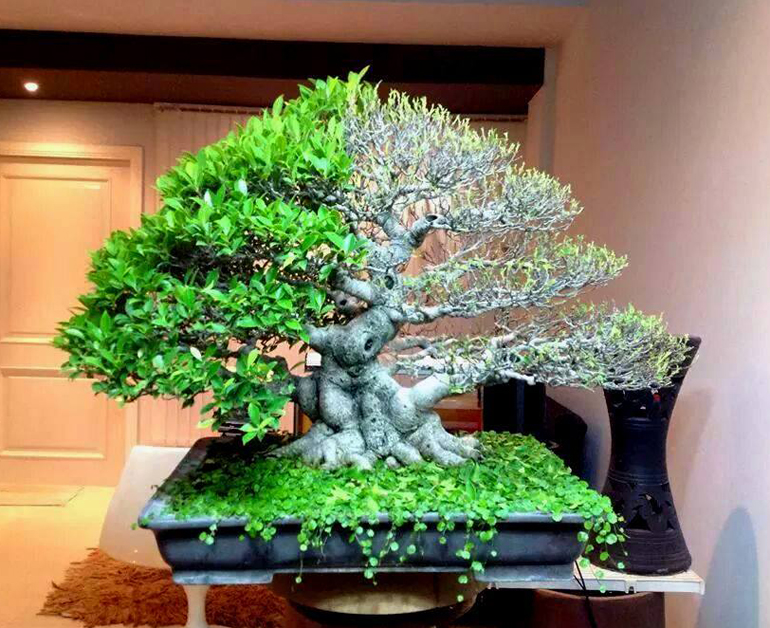
This photo is the inspiration for starting a new series on defoliation. It's a Ficus and as you can see it's half defoliated. If you live in the tropics you can defoliate a tree like this any time of year. If you want to defoliate a Ficus or other tropical bonsai here in the north country, you need to wait until it's pretty warm (let's say until night temps are over 50F, 10C). If you defoliate too soon, cold nights could hamper recovery. Conversely you don't want to wait too long into the summer as you want full recovery before nights starting getting cold. The photo is originally from Eduardo Mourão Guedes's post in Indonesian Bonsai Society (couldn't find a live link for this). I found it in Tae kukiwon bonsai's facebook photos.
As mentioned above this post marks the beginning of a series on defoliation. We’ll start with defoliation for energy balancing. In general, whether discussing defoliation or other techniques, energy balancing is critical for successful bonsai.
Before you get too far into an article like this, the question of when to defoliate is bound to come up. We touch on it briefly under Timing below, but there’s much more that can be said. In a nutshell, when to defoliate depends upon where you live and the type tree. In warm climates people sometimes defoliate the same tree two or even three times in one growing season. In cold climates once is all we can squeeze out. This is because of the need for ample recovery time before the cold weather sets in.
For the rest of this post we’re going to borrow liberally from a defoliation post we put together way back in 2009.
This Japanese maple (Acer palmatum) has been partially defoliated. The first branch is too small relative to the rest of the tree, so the purpose of the defoliation is to speed up the development of the first branch while slowing down the development of the rest of the tree. This works because energy flow decreases in areas that have been defoliated. Conversely, because the energy from the roots has to go somewhere, energy flow increases where leaves are left on. The photos in this post are from Bonsai Today issue 103. The article that the photos are taken from is by Hiroshi Takeyama.
Before defoliation. Too much energy is flowing to the upper reaches of the tree. Without redirecting this energy, the top will continue to strengthen, while the lower branch remains relatively weak. This occurs because most trees (including maples), are apically dominant, i.e. most of the energy flows up towards the tree's apex. Because of this disproportionate energy flow, it would be impossible to style most bonsai without some sort of energy balancing.
Defoliation Defined
Defoliation is simply cutting off foliage (leaves). Though the word defoliation is used outside of bonsai to describe conditions caused by chemicals or disease, it is distinctive to bonsai as a styling technique.
Three primary reasons to defoliate
For styling purposes, defoliation is commonly used for three purposes: reducing leaf size, increasing fine branching (ramification) and redirecting energy. This post is primarily concerned with the third purpose; redirecting energy.
Defoliating for health
Defoliation can also be used to remove diseased or insect infested leaves. Or leaves that have been damaged by sun, wind or other factors.
When wiring
It’s not unusual to remove some leaves when you wire just to get them out of the way.
When pruning
Sometimes it helps to remove some leaves on a branch before pruning so you can better see exactly where to cut.
Timing
If you plan on doing extensive defoliation, be sure to give the tree plenty of time to recover and develop strong new leaves before cold weather starts to set in. Here in Vermont this means we need to defoliate in the early summer. In warmer climes you can defoliate well into mid-summer.
How to defoliate; coming soon
Stay posted, we’ll cover the how-to next time. Meanwhile, if you insist on going ahead, by sure to use sharp shears and to cut the petioles (leaf stems) at the half way point.
Only the apex has been defoliated on this maple. Because maples and most trees are apically dominant, it is sometimes necessary to redirect energy downward. You could accomplish this by simply pruning off the top of the tree, but in this case, the artist wants to keep the top as it is (at least for now) while encouraging growth in the rest of the tree.
Stay posted for much more on defoliation and other energy balancing topics.

Japanese maples are prime candidates for defoliation. And even though the tree on the cover is a Trident maple, the majority of this book is devoted to Japanese maples. You can find it at Stone Lantern. On special.
Great Why and How to article. Amateurs and Hobbyist like me need more of these so we know there is a Horticultural reason for almost every think we do.
Keep them coming.
Thanks Paul,
Your positive feedback is appreciated. For some reason we seldom get feedback of any kind on how-to articles, so we haven’t emphasized them as much as we could.